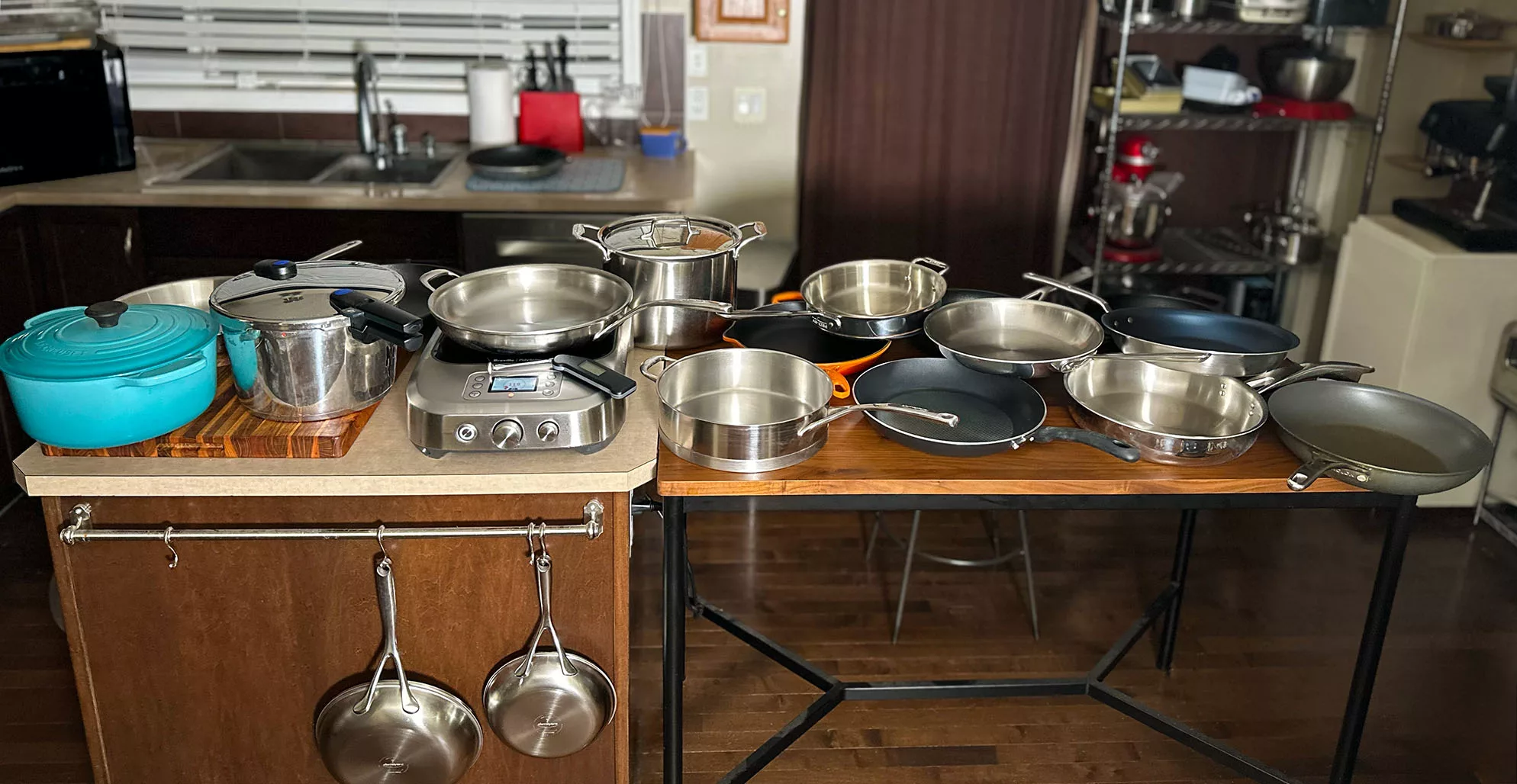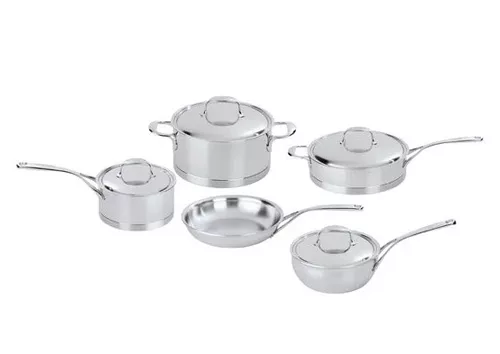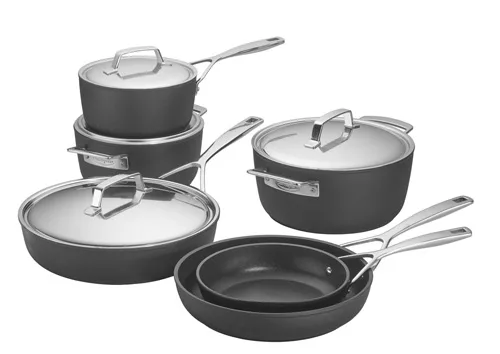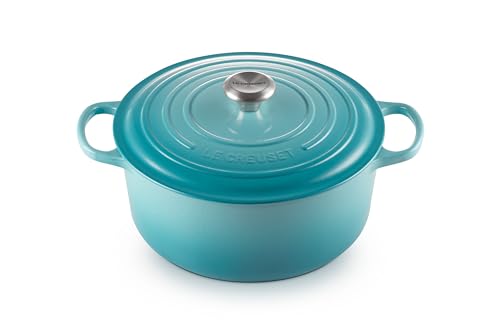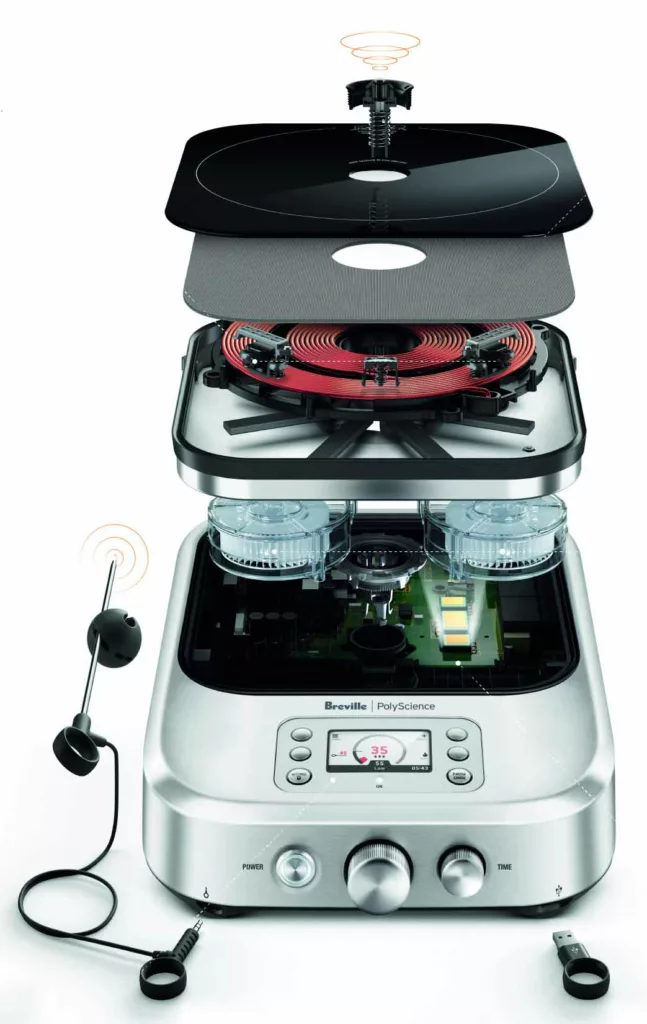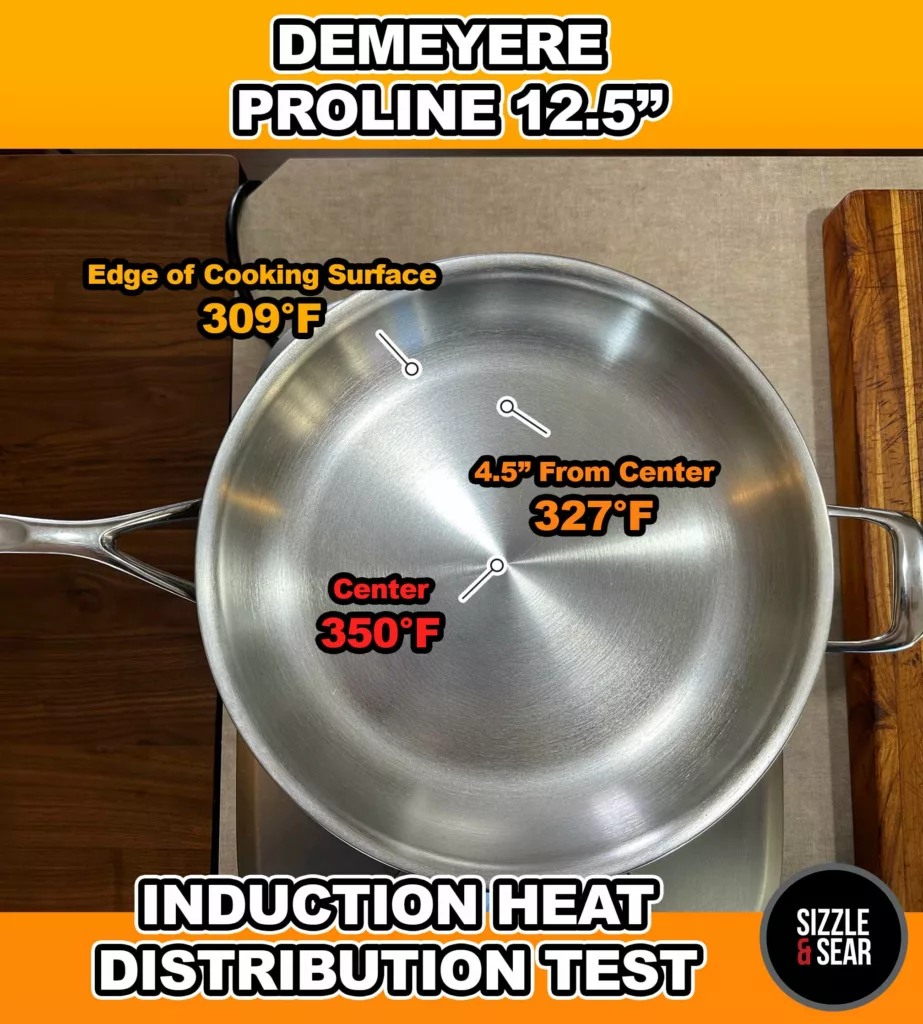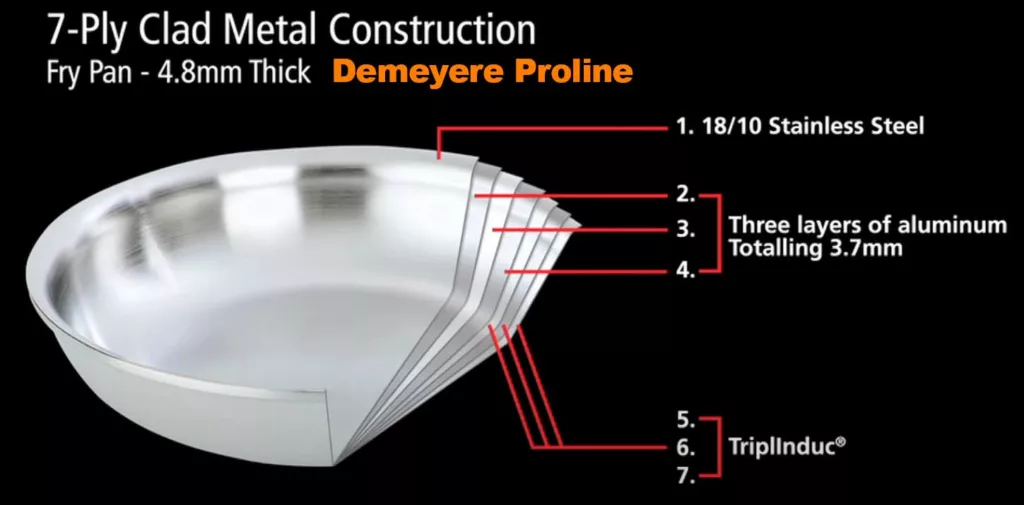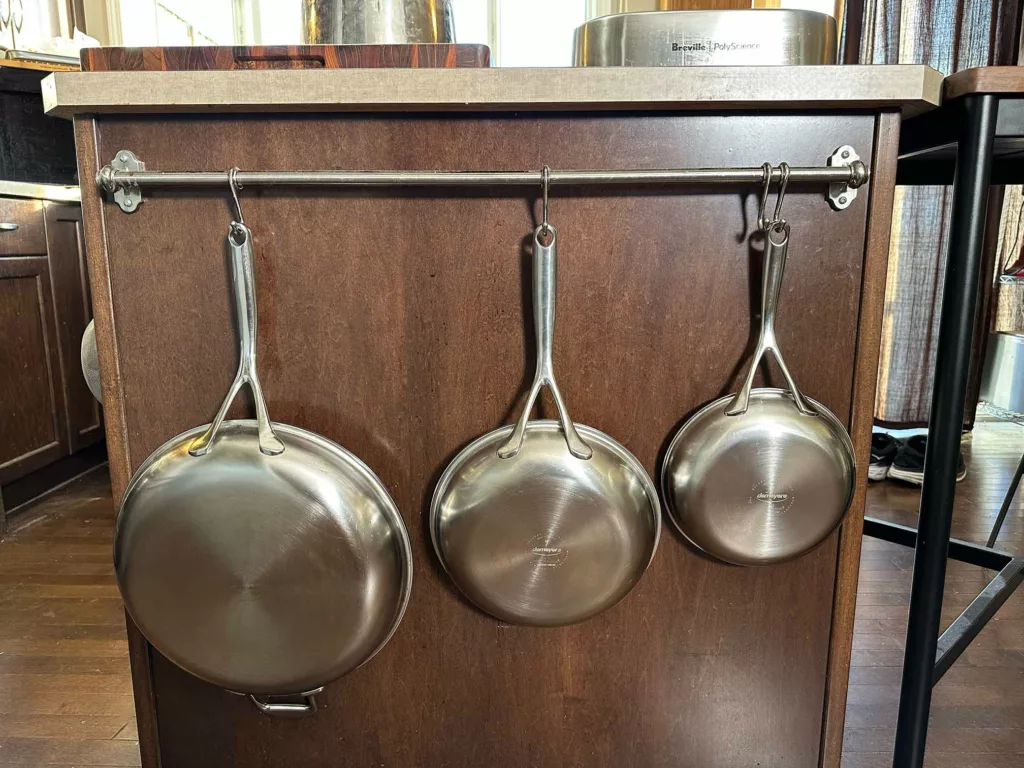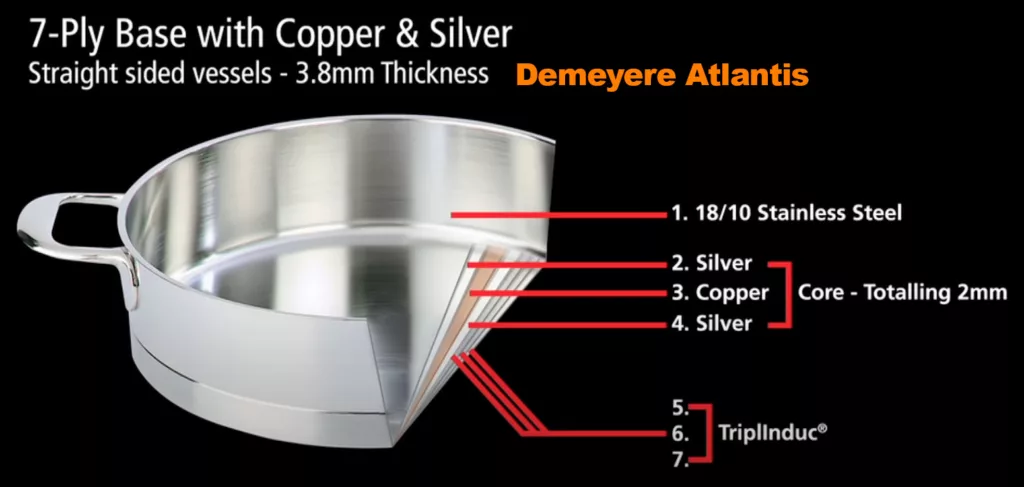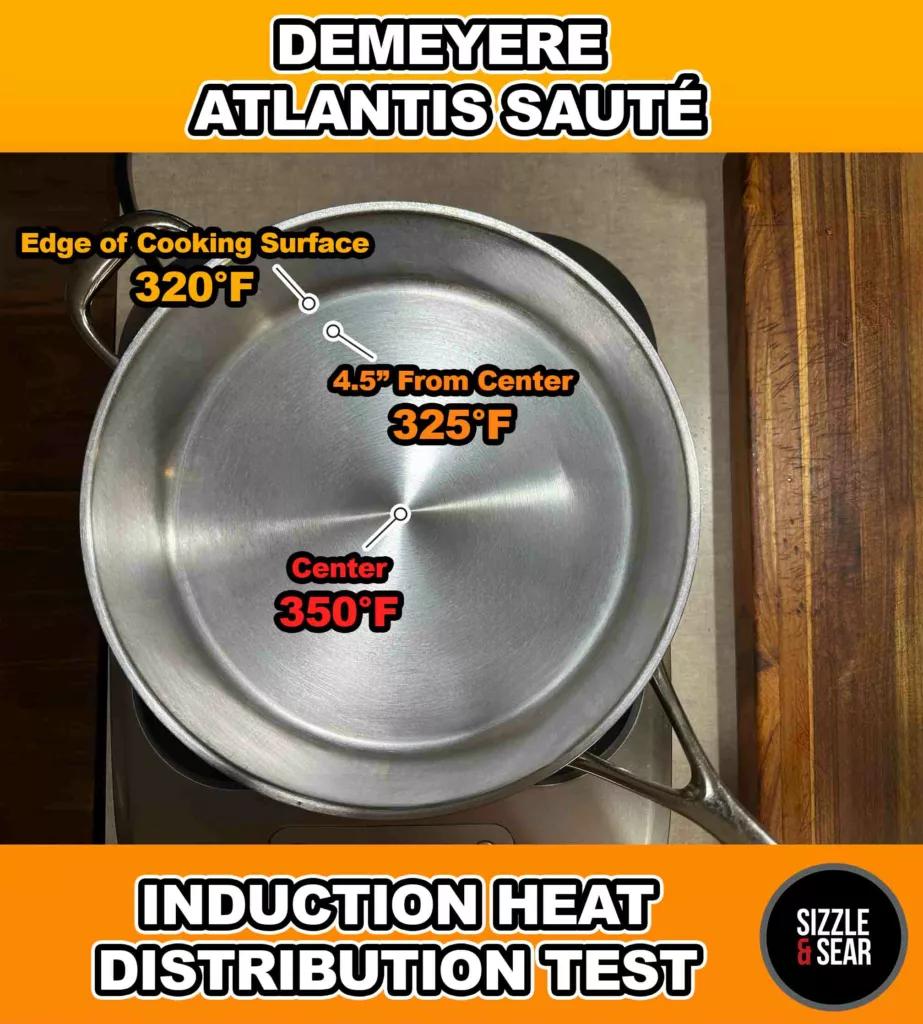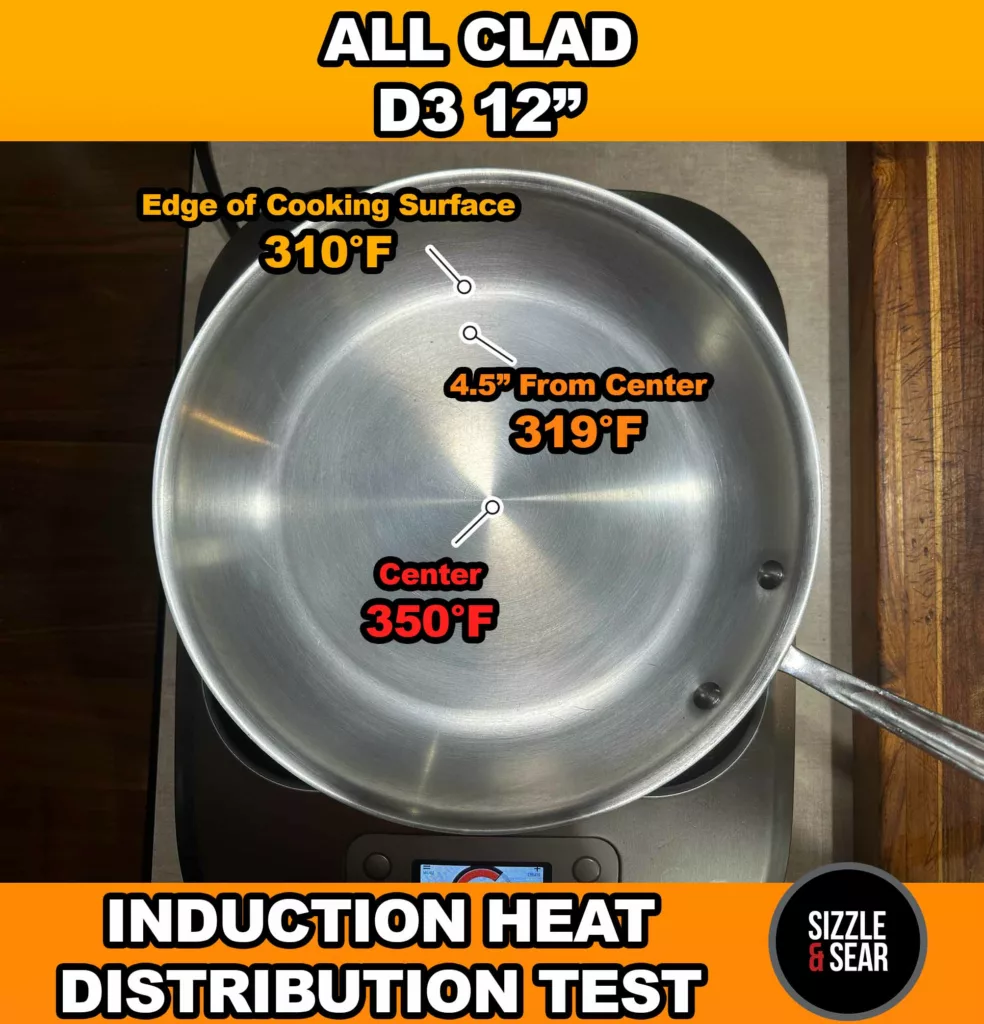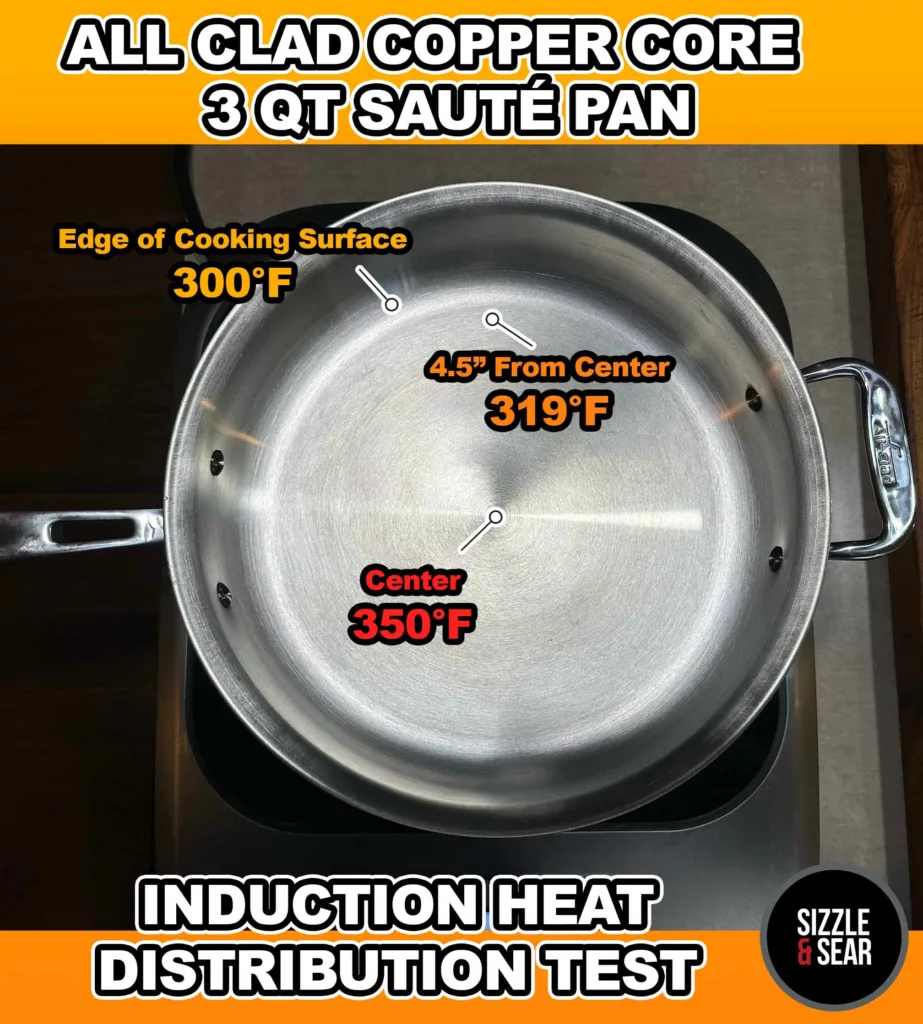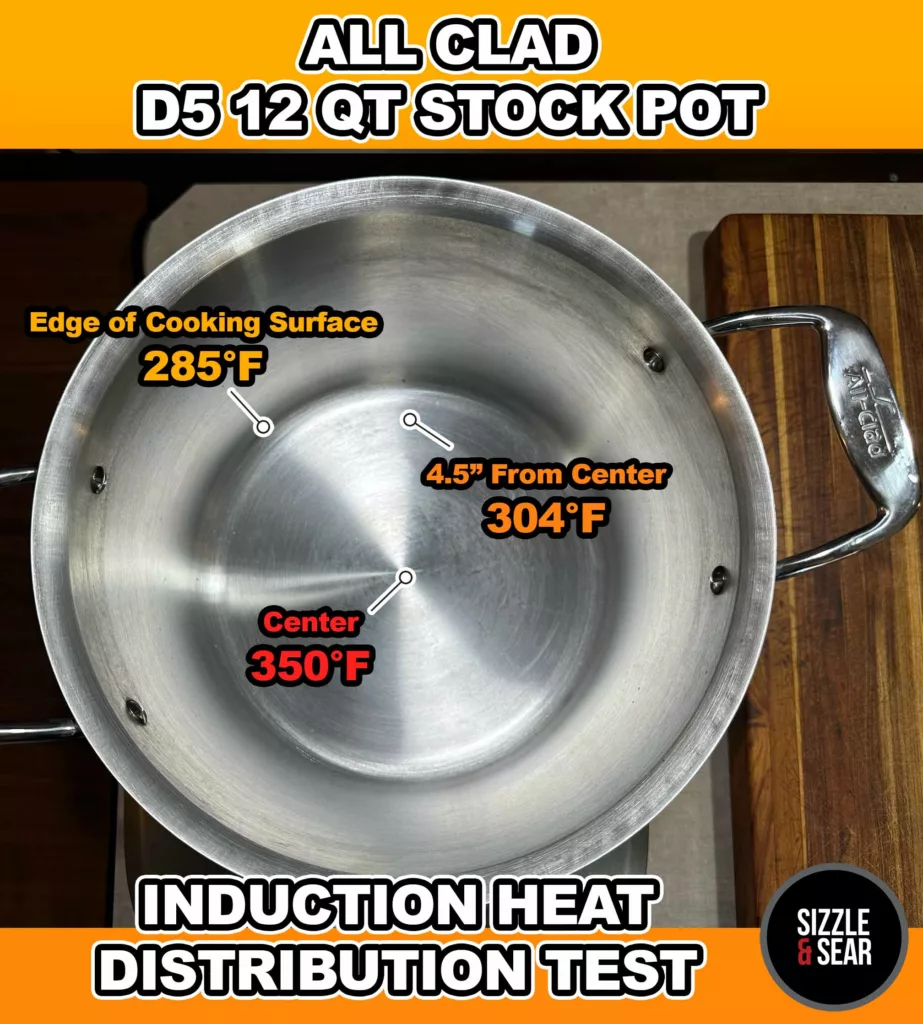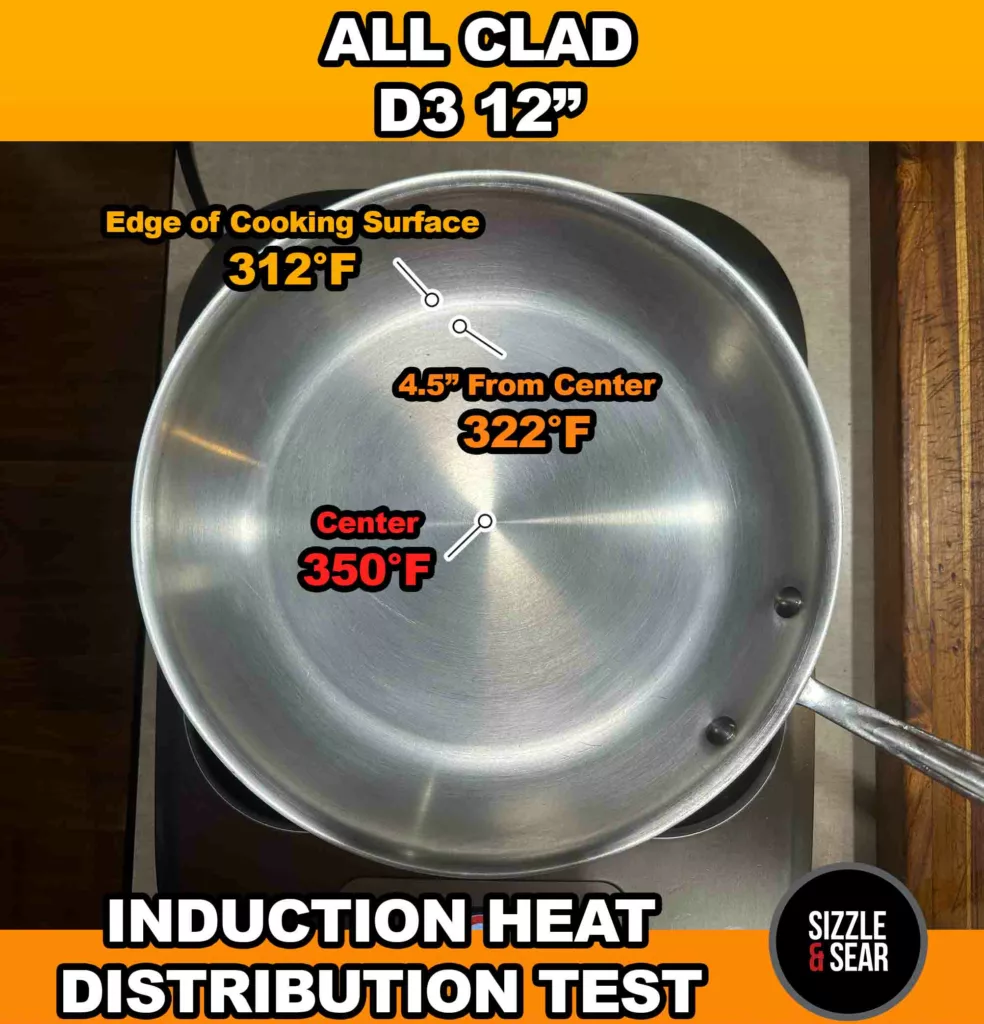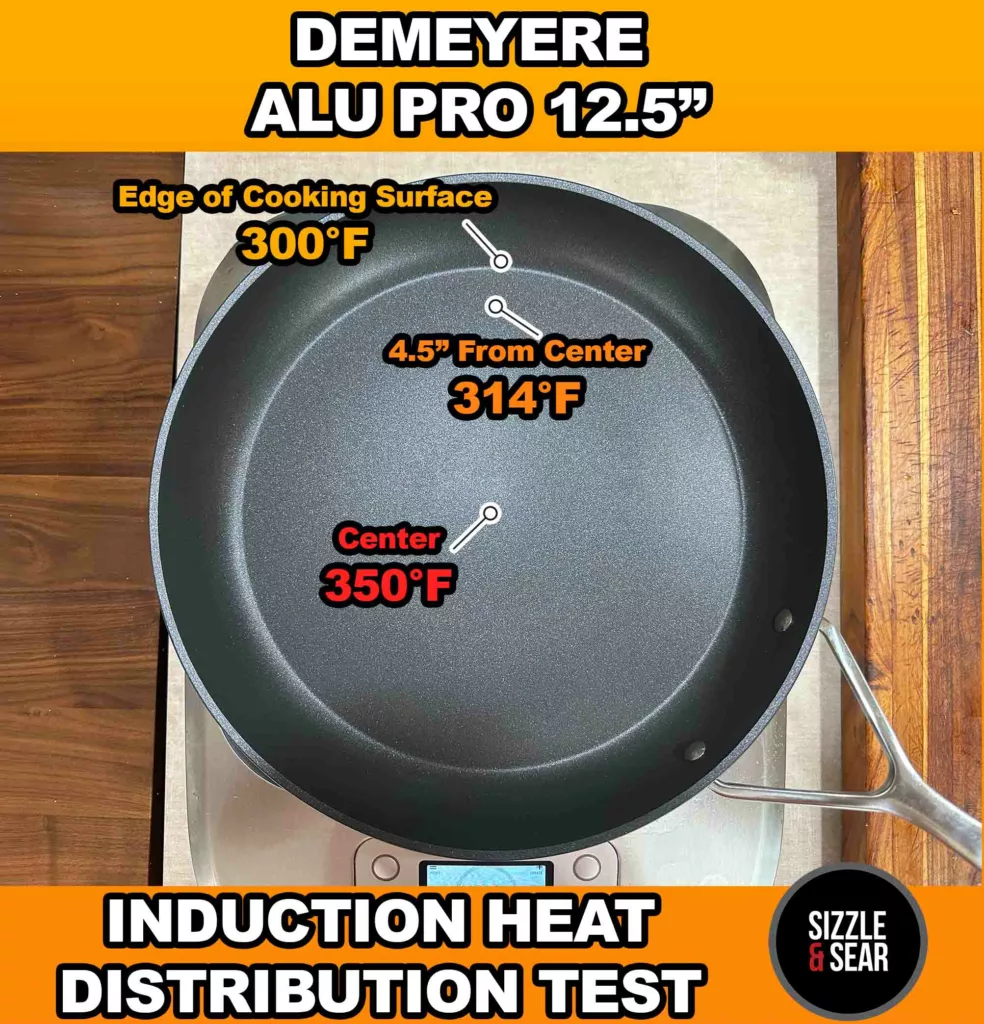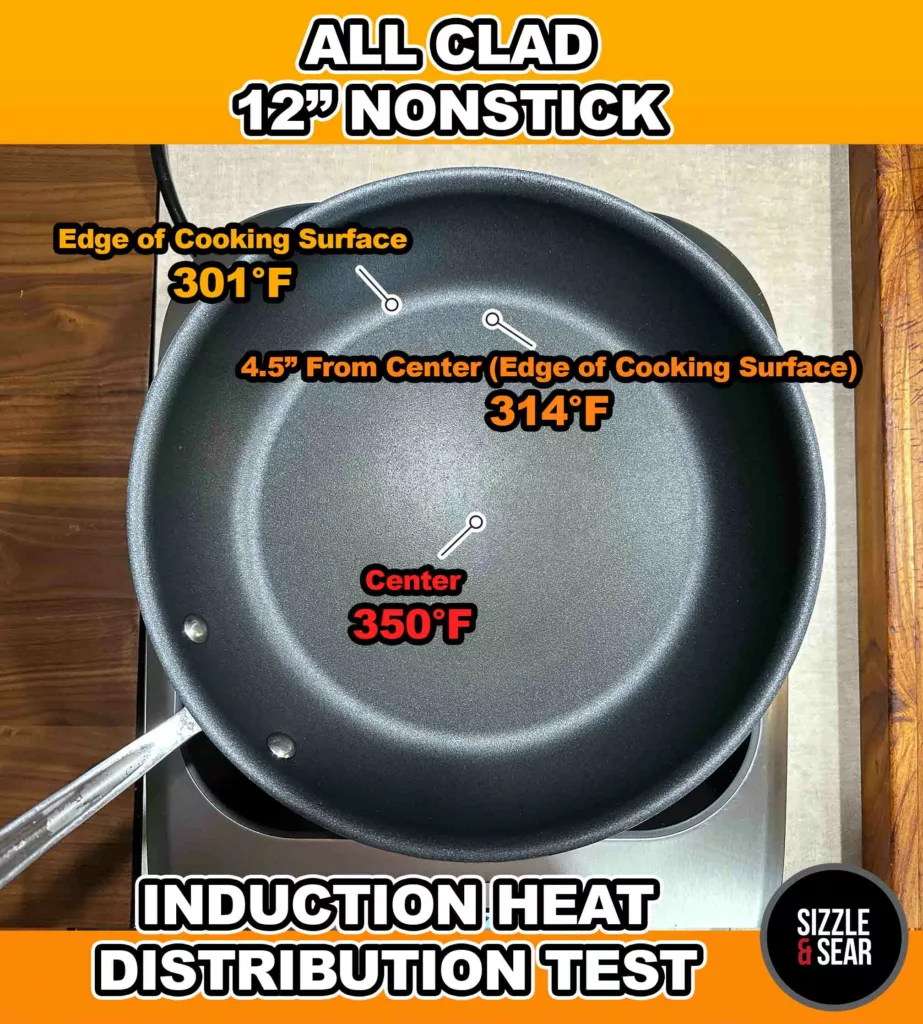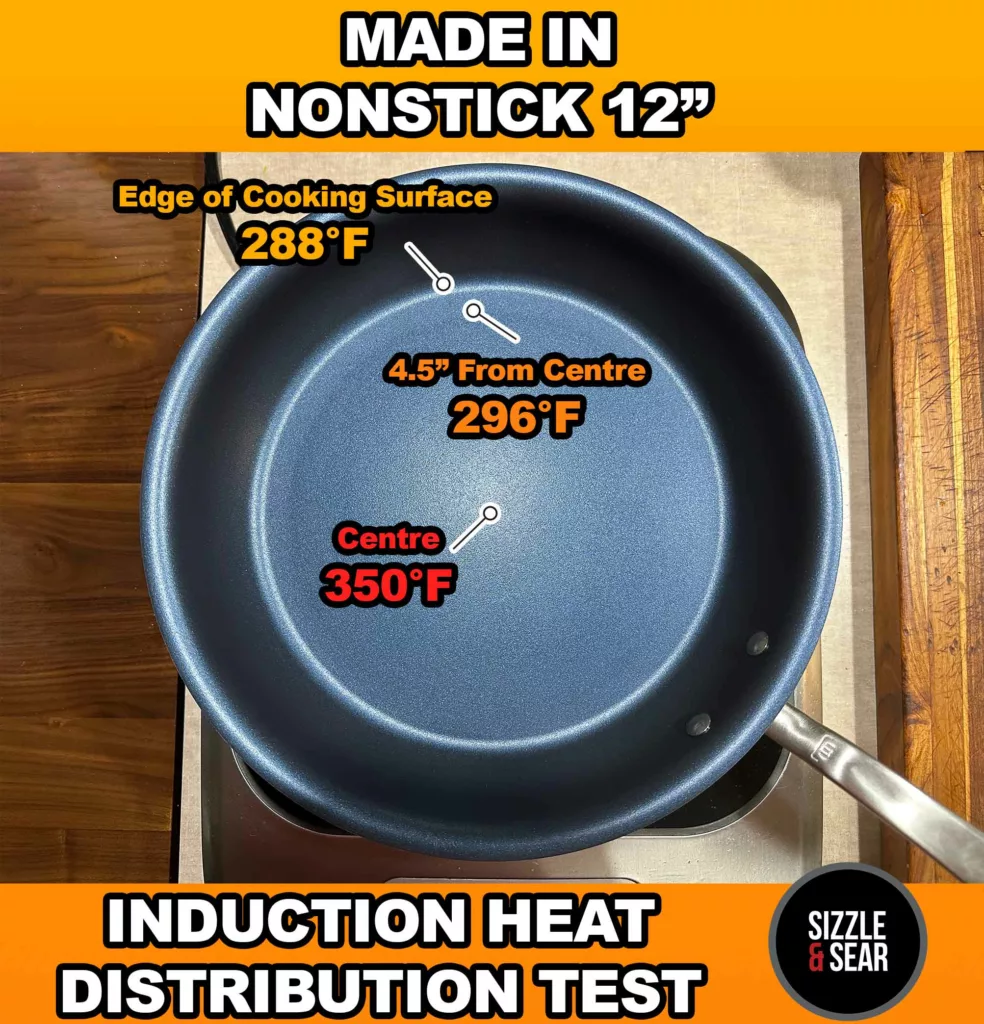Quick Results
My Favorite
Although they didn’t quite place first in my tests for even heat distribution, both Demeyere Atlantis and Proline cookware performed exceptionally well (losing just 25°F/23°F in temperature 4.5″ from the center of the pan on an undersized induction burner.) They also look great and release food easily!
Atlantis is Demeyere’s 7-ply construction for pots and pans with straight walls. They are disc bottomed with a 2mm copper core lined in silver.
Proline is Demeyere’s 7-ply fully clad construction for frying pans. At its core is a whopping 3.7mm of aluminum for great heat distribution and retention!
Atlantis and Proline are sold together in sets or individually.
Best Stainless
I tested the Fissler Vitaquick pressure cooker with a CookStar base, and I was super impressed. There was only a 11°F difference in temperature between the middle of the pot and the very edge of the pot while heating the pot on an undersized induction burner!
Luckily the 8mm thick CookStar base is also available through the Fissler Profi line of cookware, which includes pots and pans of various sizes. For the most versatile pan, I’d recommend the 5.1 quart 11-inch roaster, which is essentially a sauté pan with two short handles instead of a long handle. Sauté and roaster pans like this are great as they can act as a large frying pan and have the capacity of a small stockpot.
While aesthetically speaking the Profi’s design is not my favorite, you can’t beat this level of even heat distribution!
Best Nonstick
The Demeyere Alu Pro 12.5″ fry pan tied with All Clad D3 nonstick, as the best nonstick pan for even heating. However, the Demeyere Alu Pro has a larger capacity. The Demeyere also has a slight edge over the All Clad as the Demeyere just as effectively distributed its heat to the edge of the pan as the All Clad, but the Demeyere had to distribute it further because of its larger cooking surface.
Eggs slipped and slid easily on this pan, and it only lost 36°F in temperature 4.5″ from the center of the pan on an undersized induction burner.
Many will scoff at spending this kind of money on a non-stick pan that will eventually need to be thrown away. If that’s a concern, then I recommend the Anolon Nouvelle Copper or Ninja Foodi NeverStick pans. They don’t have quite the same heat distribution as the Demeyere, but they’ll easily fry an egg for you.
Best Enameled Cast Iron
Cast Iron is a poor conductor of heat when compared to aluminum or copper. So it’s no surprise that the best performing cast iron pot performed more poorly than the poorest aluminum clad, disc-bottomed, and nonstick pans in my cookware lineup. The Le Creuset French (Dutch) oven lost 68°F in temperature 4.5″ from the center of the pan on an undersized induction burner.
That being said, the Le Creuset French (Dutch) Oven is good at retaining heat for soups and stews that go in the oven, and it’s easier to maintain than bare cast iron. It’s also as a showstopper centerpiece for your kitchen. But for stovetop cooking, I recommend sticking with one of the higher rated stainless steel pots that will more evenly distribute the heat.
Table of Contents
Introduction: Why is Even Heating in Cookware Important?
One crucial aspect of cookware is its ability to heat evenly and distribute heat effectively. Achieving even heat distribution is especially critical when the heat source is smaller than the pan’s bottom diameter. This is often the case for home cooks who want to cook in pans with a 9″ or greater cooking surface (the typical 12″ fry pan falls into this category), or home cooks who are cooking large meals that involve multiple large pans that will quickly use up their large burners.
The material your cookware is made out of is a key factor when it comes to heat distribution, but so is the thickness of that material. Copper, an excellent heat conductor, may not deliver optimal results if it’s in a super-thin layer. In contrast, thick layers of aluminum clad between stainless steel can outperform a thin layer of copper.
Instead of just trusting manufacturer’s claims of even heat distribution, I decided to test a variety of pots and pans. My goal is to keep this heat distribution guide updated as I acquire new pieces of cookware. Eventually, I’ll be expanding the scope of this page to include additional metrics, such as heat retention and speed of heat distribution. I also plan on purchasing a thermal camera soon, and I will add pictures of those results as they come in.
You can continue reading about my methodology or use the table of contents above to navigate to specific results.
Methodology: How I Tested Cookware for Even Heat Distribution
All cookware was tested on the Breville Commercial Control Freak, a precision induction unit (Read my in-depth review of the Breville Commercial Control Freak). Based on graphics provided by Breville (see below), I estimate that the induction coil of the Breville Control Freak is ~8 inches. All the pans tested have a cooking surface of at least 9 inches in diameter, so temperature readings 4.5″ and beyond from the center of the pan should reveal the pan’s heat distributing capabilities.
The Control Freak stabilized the temperature of the center of the pan to 350°F. After the cookware hit the target temperature, it stayed at the temperature for 5 minutes to allow the heat to properly distribute across the pan. Waiting to allow the heat to fully distribute is important because heat doesn’t spread across the pan instantly.
The ThermoWorks Pro Surface Thermapen was then used to measure temperatures at points 4.5″ away from the center, allowing for an average temperature calculation. This standardized approach facilitated a fair comparison of cookware, provided they had a minimum cooking surface of 9 inches.
Additionally, temperature measurements were taken at the very edge of the cooking surface and averaged. This approach unveils a rough gradient of heat distribution for each pan.
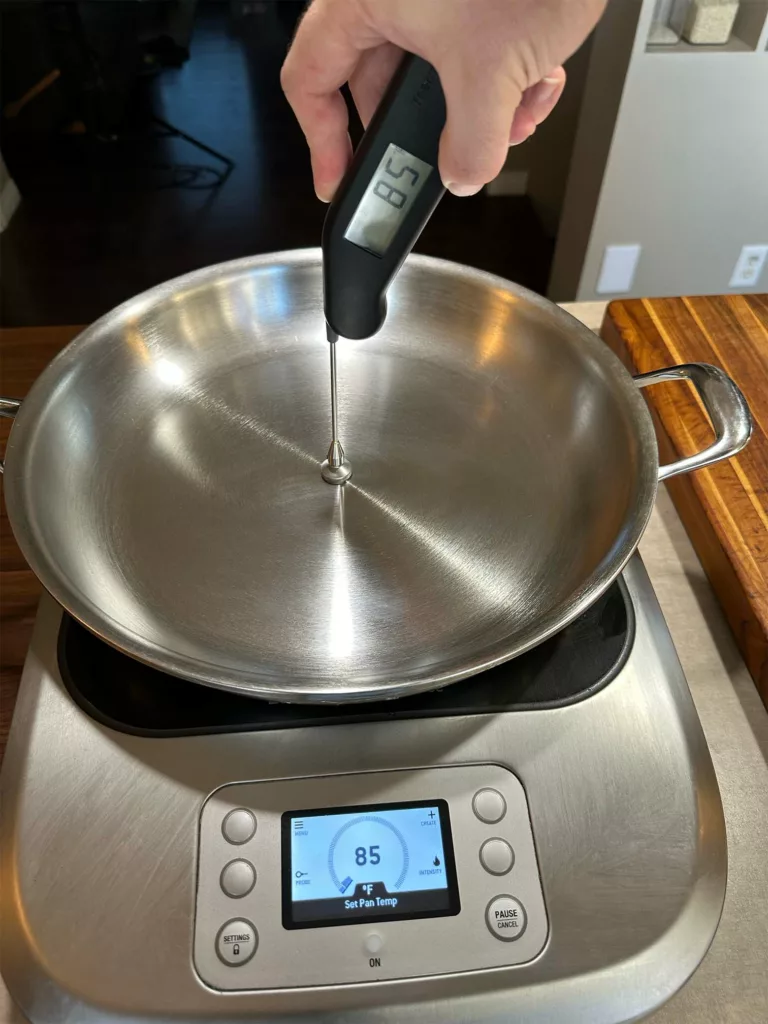
Results: Cookware Heat Distribution By Cookware Type, Brand, and Model
Stainless Steel Clad and Disc Bottom Cookware
| Heat Rank | Cookware | 4.5" Temp Change* | |
|---|---|---|---|
| #1 | Fissler products with Cookstar Base: such as Vitaquick and Vitavit pressure cookers, and Profi series cookware | 11°F | Details |
| #2 | Demeyere Proline | 23°F | Details |
| #3 | Demeyere Atlantis | 25°F | Details |
| #4 | All Clad D7 (discontinued) | 28°F | Details |
| #5 (tied) | All Clad Copper Core | 31°F | Details |
| #5 (tied) | All Clad D3 | 31°F | Details |
| #6 | Zwilling TruClad | 41°F | Details |
| #7 | All Clad D5 | 46°F | Details |
| *See methodology above. The lower the 4.5" temp change number, the more even the heat distribution. | |||
Nonstick Cookware
| Heat Rank | Cookware | 4.5" Temp Change* | |
|---|---|---|---|
| #1 (tie) | Demeyere Alu Pro | 36°F | Details |
| #1 (tie) | All Clad D3 Nonstick | 36°F | Details |
| #2 | Anolon Nouvelle Copper Nonstick | 41°F | Details |
| #3 | Ninja Foodi NeverStick | 50°F | Details |
| #4 | Made In Nonstick | 54°F | Details |
| #5 | T-Fal Professional Total Nonstick | 60°F | Details |
| *See methodology above. The lower the 4.5" temp change number, the more even the heat distribution. | |||
Cast Iron Cookware (Enameled and Non-Enameled)
| Heat Rank | Cookware | 4.5" Temp Change* | |
|---|---|---|---|
| #1 | Le Creuset Enamelled Cast Iron French (Dutch) Oven | 68°F | Details |
| #2 | Lodge Cast Iron Skillet | 74°F | Details |
| #3 | Le Creuset Enameled Cast Iron Skillet | 88°F | Details |
| *See methodology above. The lower the 4.5" temp change number, the more even the heat distribution. | |||
Analysis: Why Does Some Cookware Heat More Evenly Than Others?
Stainless Steel Clad and Disc Bottom Cookware
Fissler "CookStar" Base Cookware: Vitaquick and Profi Lines
The best stainless steel cookware in my heat distribution and evenness tests was a disc-bottomed pressure cooker: the Fissler Vitaquick. I bought this piece because America’s Test Kitchen rated it as the best pressure cooker, and I was not disappointed.
While disc-bottomed cookware is usually thought to be poorer than clad construction, the Fissler Vitaquick features their “CookStar” base that is super thick. Measuring the exact thickness of the base is difficult as the base appears to run up the sides a bit, but according to Fissler their CookStar bases are 8mm thick. How much of that is aluminum and how much of that is stainless is unknown, but it’s clearly lot of aluminium as the Vitaquick only lost 11° F at 4.5″ from the center of the pan; the #2 stainless steel pan for heat distribution lost more than double that!
While I haven’t had the privilege of personally testing the Fissler Profi collection of cookware, they also feature a CookStar base and should perform just as well as the Fissler Vitaquick. I’d like to one day try out the 5.1 quart 11-inch roaster, which is essentially a sauté pan with two short handles instead of a long handle. Sauté and roaster pans like this are great as they can act as a large frying pan and have the capacity of a small stockpot.
I will admit that aesthetically speaking the Profi’s design is not my favourite, but you can’t beat this level of even heating and distribution!
Fissler cookware is manufactured in Germany.
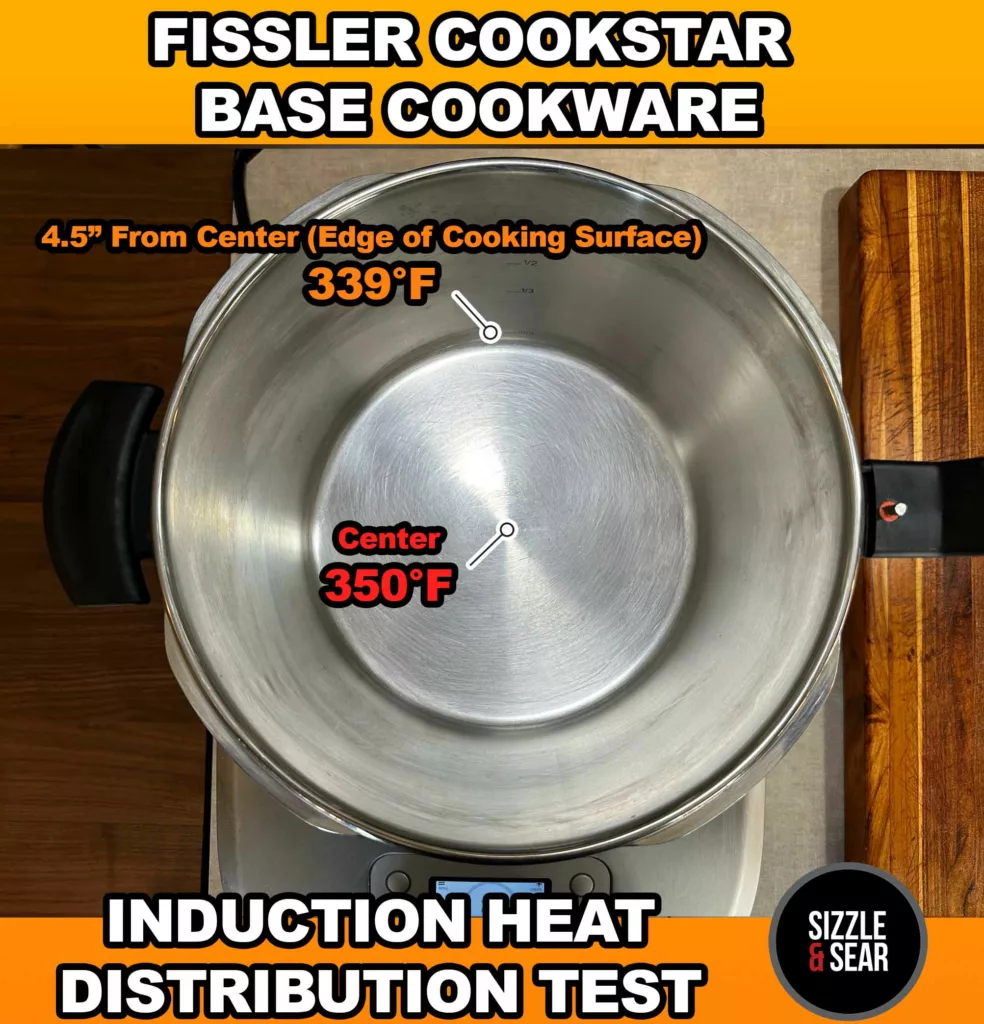
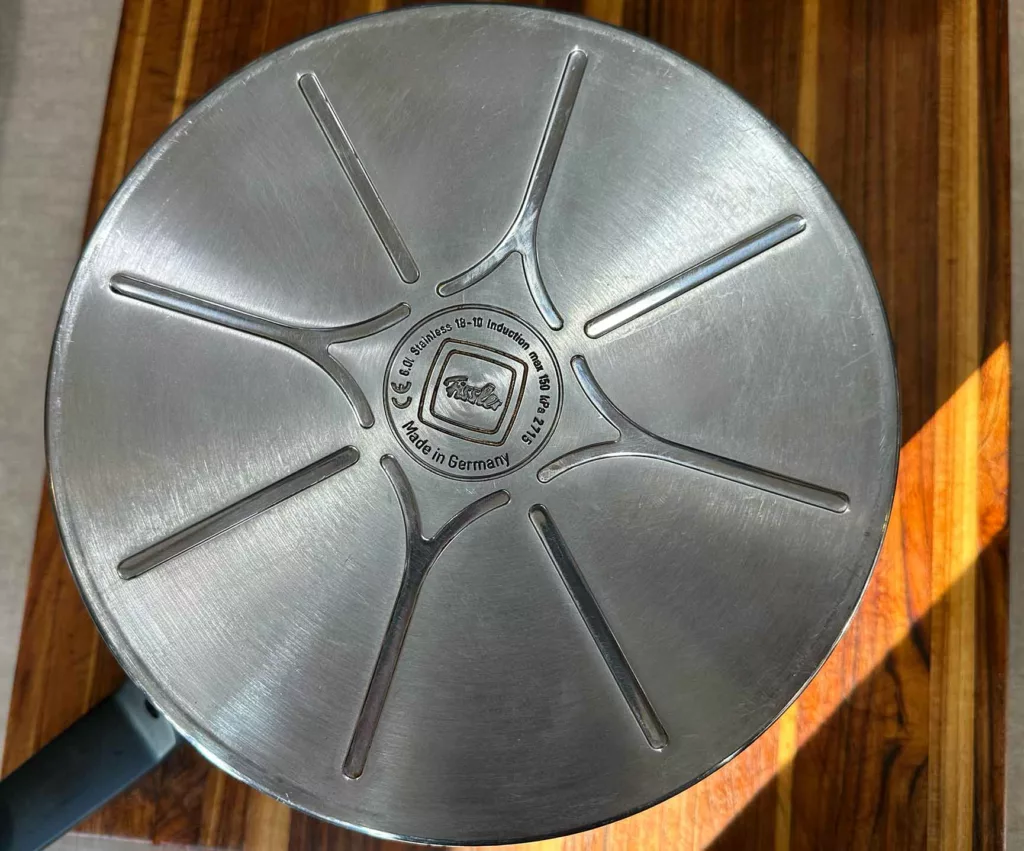
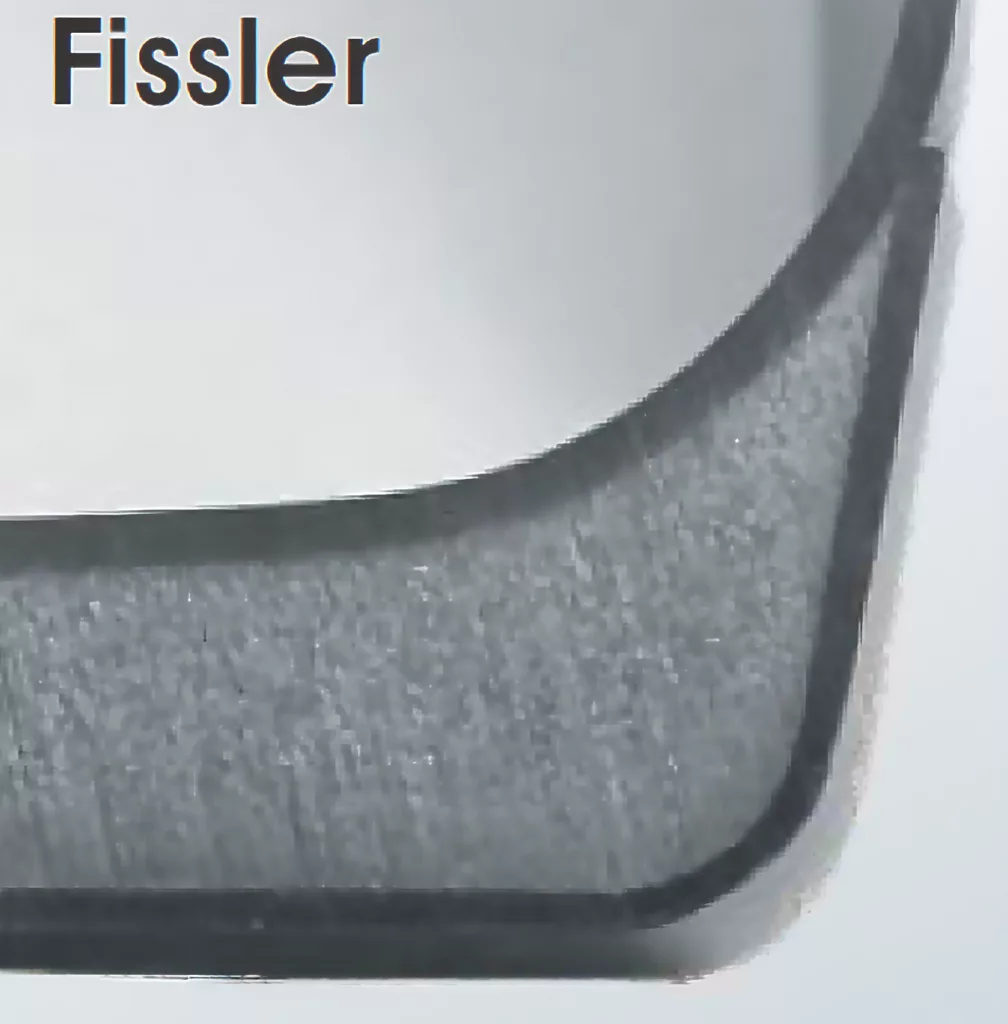
Demeyere Proline and Atlantis Cookware
In second place for stainless steel is the Demeyere Proline frying pans and not far behind in third place is the Demeyere Atlantis series of cookware. The Proline only lost 23° F at 4.5″ from the center of the pan, while the Atlantis only lost 25° F.
Proline frying pans are often bundled together with Atlantis cookware in sets, but they are constructed differently.
First, the Proline is fully clad, meaning that it’s made out of aluminum sandwiched between layers of stainless steel through the entire pan, including the sides. While Atlantis cookware has a disc bottom that spans the entire cooking surface and runs up the sides a little bit.
The Demeyere Proline series is 7-ply, and it contains a whopping 3.7mm of aluminum at its core, twice the aluminum of All Clad D3 products. This results in a very heavy pan that both distributes and retains heat very well. The sides of the pan are sealed making it safer for the dishwasher than pans with exposed aluminum like All Clad. With its patented 3 layer Triplinduc base, the Proline series is optimized for induction, but will work on all cooktops.
While the Atlantis series of cookware is disc-bottomed cookware, it’s a premium product. What makes the Atlantis unique compared to other disc-bottomed cookware is not only does the disc span the entire bottom of the cookware, but it also contains no aluminum; instead, it contains 2mm of highly conductive copper sandwiched between two thin layers of even more highly conductive silver. All this is encapsulated inside a stainless steel disc. The bottom of the disc contains three layers of stainless steel, known as Triplinduc, which is again specifically engineered for induction cooking, but usable on all cooktop types.
Because of the capacity, large diameter, and heat distribution of the Demeyere Atlantis 11″ sauté pan, it has become a workhorse in my kitchen and I highly recommend it.
Both the Atlantis and Proline range feature Demeyere’s patented finishing technique: Silvinox. The uniqueness of this finish is noticeable; they are less prone to finger prints and seem to clean up easier. They even seem to release food better; one of my favorite things to cook in my Proline is a French omelette, and I can do so without it browning or sticking—amazing for stainless steel!
Demeyere cookware is manufactured in Belgium.
All Clad D3, D5, D7, and Copper Core Cookware
The All-Clad D7 is another 7-ply series of cookware, but unfortunately it has been discontinued. In terms of heat distribution, it ranks between the All-Clad D3 series and the Demeyere Proline series, losing 28° F of heat at 4.5″ from the center of the pan.
All Clad Copper Core tied with the All Clad D3, both losing 31° F of heat at 4.5″ from the center of the pan. This makes sense if you think about it. While copper is more conductive than aluminum, the All Clad Copper Core series has just over half as much copper as D3 has aluminum. With copper being roughly twice as conductive as aluminum, this makes both the D3 and Copper Core pretty much identical in conductivity. It is important to note though that copper will heat and cool down faster than aluminum, which can be a positive or negative depending on what you are cooking.
The All Clad D5 ranked last in my tests (lost 46° F of heat at 4.5″ from the center of the pan), even behind the All Clad D3. At first glance this seems counter intuitive, as the D5 contains 5 layers and the D3 contains 3 layers. However, the D5 actually is the same overall thickness of D3, just with more layers of stainless steel. These extra layers of stainless steel replace highly conductive aluminum. This proves that more layers isn’t always better. You got to ask what those layers are made up of.
If you’re adamant about going with All Clad, I would not recommend the D5 series when it comes to heat distribution and evenness. I’m interested in performing some heat retention tests though. I hypothesize that the D5 may perform better because the extra layers of stainless steel could act as insulators.
Most All Clad Cookware is manufactured in the United States of America.
Zwilling TruClad
The Zwilling TruClad fry pan is more of a hybrid mix of a fry pan and a sauté pan than just a fry pan. Fry pans tend to have sloping shallow sides, while sauté pans have more straight walls (both tall and short); the Zwilling Truclad has a bit of slope but most of the wall is straight up. This is great for braises and other dishes that require both dry and liquid heat.
The Zwilling TruClad didn’t perform as well as the other clad options in our line up, losing 41° F at 4.5″ from the center of the pan.
I wasn’t able to find the TruClad lineup on the USA Zwilling site, but it is available on the Canadian site. In Canada, the regular price of 12″ pan tends to be a bit cheaper than the All Clad D3 12″, but the All Clad comes with a lid. If your choice is between the All Clad and Zwilling TruClad, I recommend going with the All Clad for better even heating unless you can find the TruClad at a signifiant discount.
Zwilling TruClad cookware is made in China.
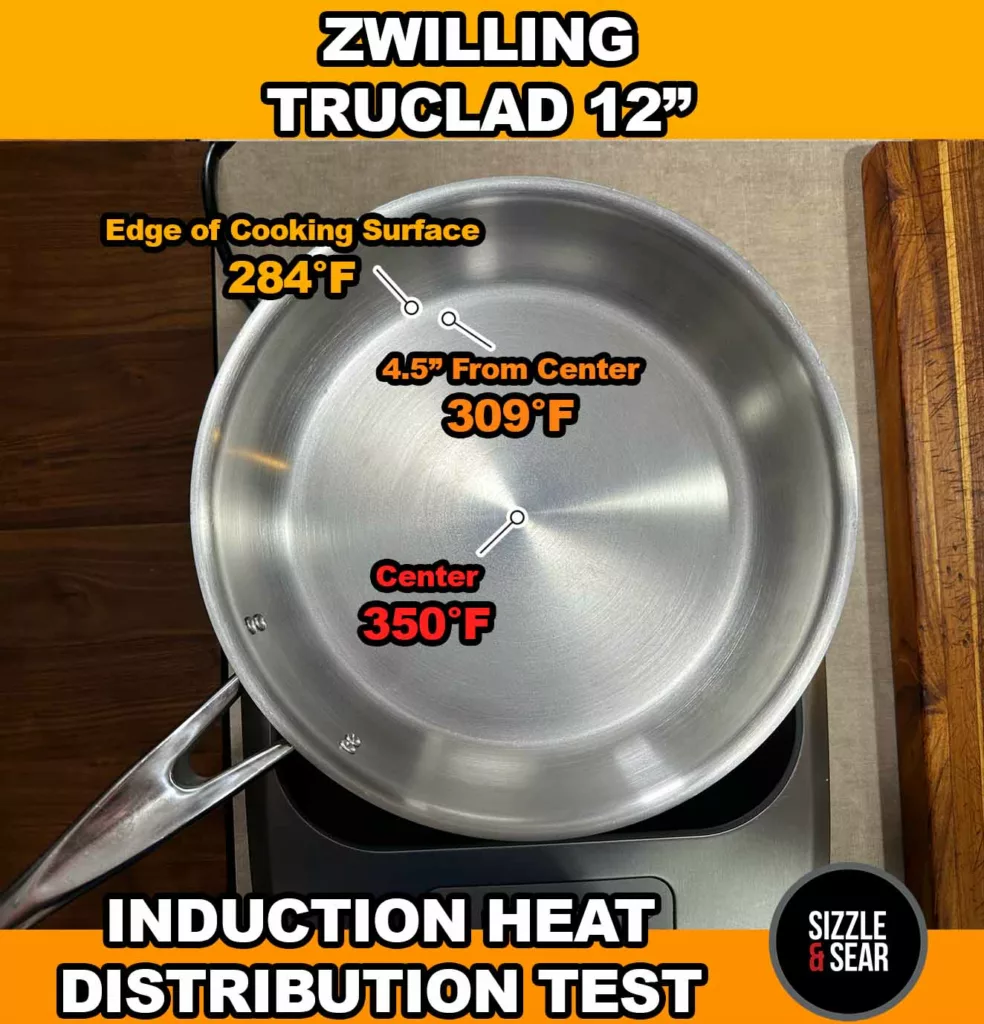
Nonstick Cookware
Demeyere Alu Pro and All Clad D3
The best nonstick cookware in my heat distribution and evenness tests were the Demeyere Alu Pro and All Clad D3 nonstick. Both tied for first place as they lost just 36° F at 4.5″ from the center of the pan.
The Alu Pro pan that I tested was 12.5″ with fairly straight walls, making it more a sauté pan than a fry pan. The added diameter and the straight walls increased the capacity of the pan compared to the D3. The bottom of the pan has a ridge design which I assume helps to distribute the heat. Eggs, as expected, slipped and slid around the pan with ease.
Demeyere says its base is 5mm, but it’s not clear how much of that is highly conductive aluminium.
The All Clad D3 nonstick is constructed in an almost identical way as the stainless D3; the only addition is the layer of nonstick coating at the top of the pan. In theory, this means the stainless and nonstick pan should perform almost identicaly. While there was a small drop in performance (the stainless D3 only lost 31° F at 4.5″ from the center of the pan, compared to 36° F for the nonstick D3), this could be explained by the nonstick coating not being applied perfectly evenly and the fact that the coating acts as an insulator for the pan.
Considering that the Demeyere has a significantly larger cooking surface and was able to distribute 300° F of heat to its very edge compared to the All Clad which distributed 301° F, the Demeyere has a slight edge over the All Clad if you are looking for a larger pan. 300° F and 301° F is a virtual tie and the Demeyere had to distribute that heat further than the All Clad.
Overall both the Alu Pro and All Clad D3 nonstick are very nice premium nonstick pans if you want to invest in something a little higher quality. Just keep in mind that unlike stainless steel pans, you will eventually need to discard nonstick pans as the coating will not last forever.
Note for Breville Commercial Control Freak Users: If you are specifically looking for cookware for the Breville Commercial Control Freak, I have found that the Demeyere Alu Pro significantly overshoots its target temperature before settling down. More specifically, the Control Freak initially reads out a much lower temperature than the actual pan temperature according to the Thermoworks Pro Surface Thermapen. It will eventually even out, but I think this has to do with the way that the bottom of the pan is indented (less thick) in the center of the pan and how the bottom ridge pattern affects the temperature reading. If you are using this pan on the Control Freak, I suggest slowly and manually ramping up both the power and temperature setting. The pan works fine on my full sized induction range.
Anolon Nouvelle Copper Nonstick
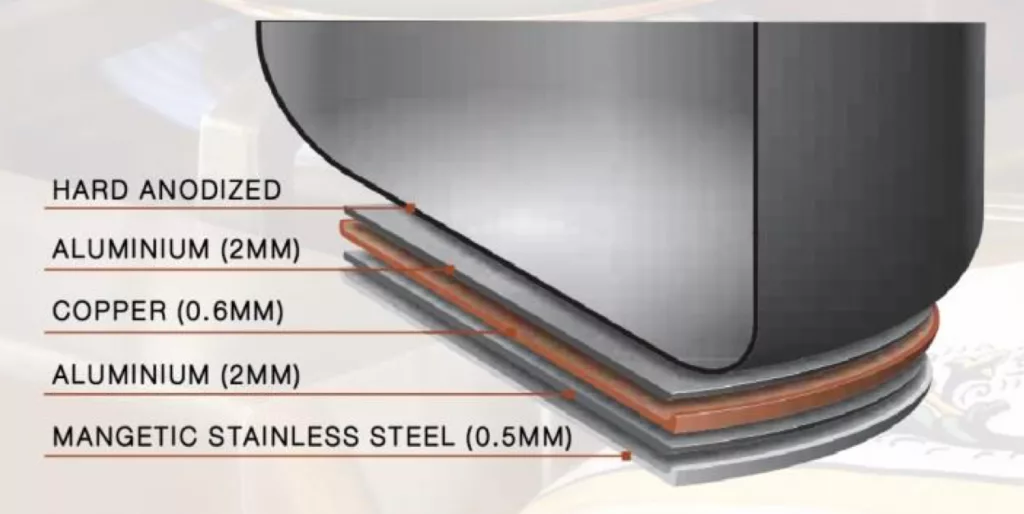
This result confused me so much that I triple tested both the Nouvelle Copper and D3 pans and the D3 beat the Nouvelle copper everytime.
When I get a hold of a thermal imaging camera, this will be one of the first pans that I measure as I am still confounded by why it couldn’t beat All Clad in my tests.
I do have a hypothesis. Assuming that Anolon’s marketing material is correct, and knowing that my Nouvelle Copper set has been used a lot more than my other nonstick pans, maybe the nonstick coating has started to delaminate and that is affecting the heat distribution.
Nonetheless the pan has been a joy to use over the years. It, being almost 6 years old, has obviously seen better days, but eggs still release from it without a problem even if they don’t slip and slide as easily as they did the day I bought it. Overall it’s a good budget pick if you aren’t keen on spending hundreds of dollars on a pan you will eventually throw out. Please note that the 12-inch skillet is difficult to come by these days, but can be found in an 11 piece set.
Anolon Nouvelle Copper pans are made in Thailand.
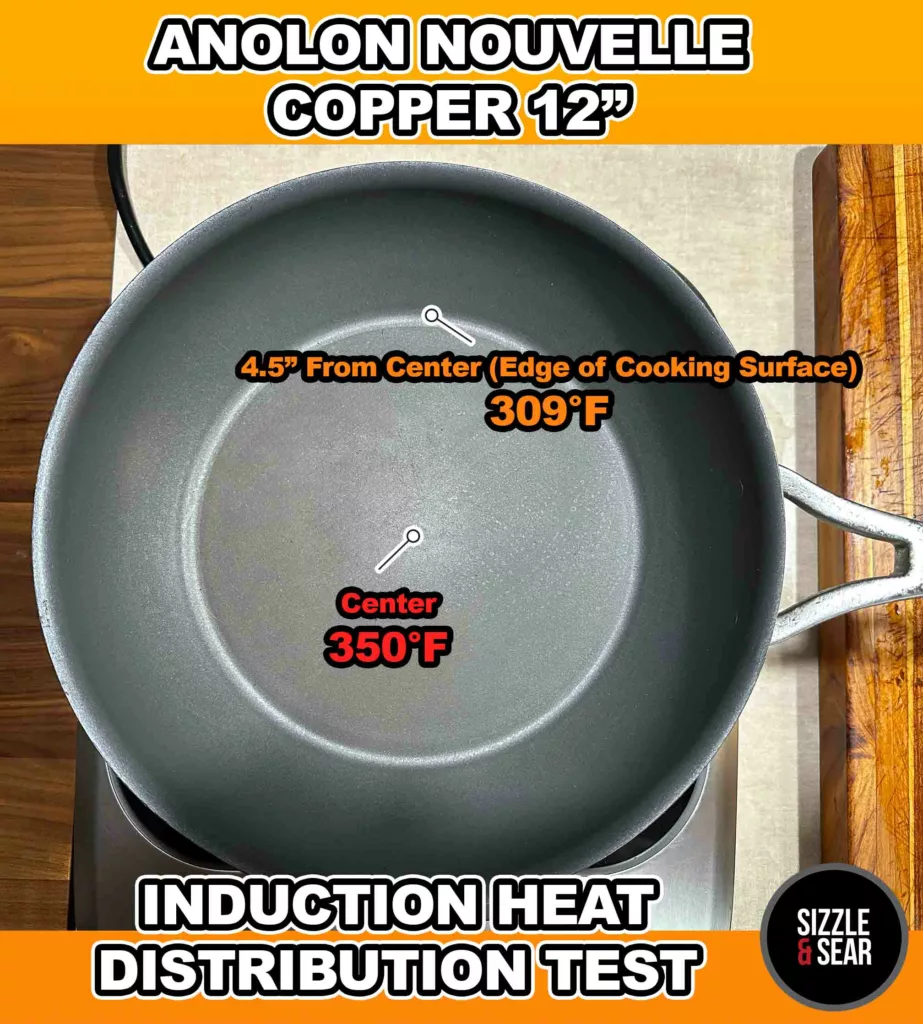
Ninja Foodi NeverStick
The Ninja Foodi NeverStick ranked in the middle of the pack of the nonstick cookware I tested for heat distribution (lost 50° F at 4.5″ from the center of the pan.) It’s a very affordable pan and is a good choice if you don’t want to fork out a lot of money on a pan that will eventually be thrown out when the nonstick coating inevitably deteriorates.
The coating itself appears to be very durable, but I haven’t owned the pan long enough to be certain.
As with all the nonstick pans that I tested, fried eggs slipped and slid with ease.
Ninja Foodi Neverstick cookware is made in China.
Note for Breville Commercial Control Freak Users: If you are specifically looking for cookware for the Breville Commercial Control Freak, I have found that the Ninja Foodi NeverStick significantly overshoots its target temperature before settling down. More specifically, the Control Freak initially reads out a much lower temperature than the actual pan temperature according to the Thermoworks Pro Surface Thermapen. It will eventually even out, but I think this has to do with the way that the bottom of the pan is indented (less thick) in the center of the pan and how the bottom perforated metal pattern affects the temperature reading. If you are using this pan on the Control Freak, I suggest slowly and manually ramping up both the power and temperature setting. The pan works fine on my full sized induction range.
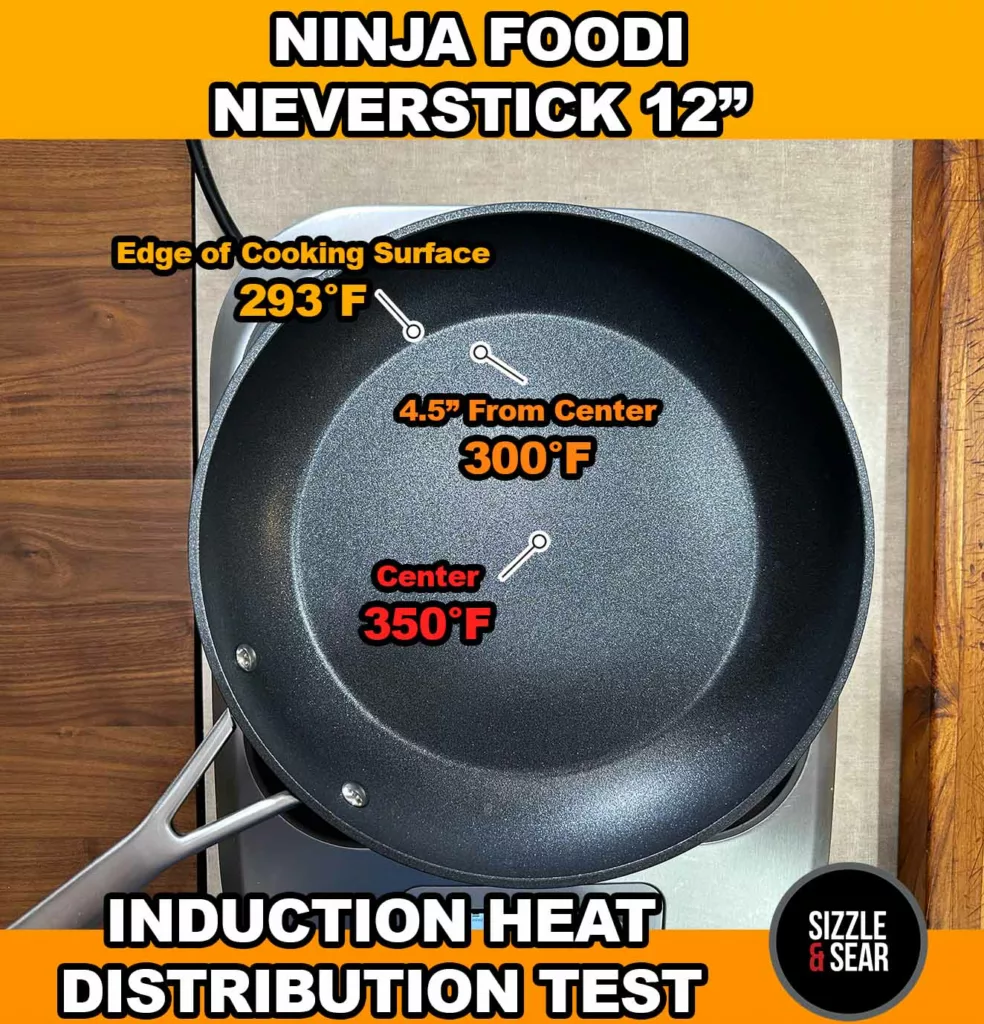
Made In Nonstick
Made In nonstick pans were my favorite nonstick in terms of how they felt and handled, even though they didn’t top the charts in heat distribution (lost 54° F 4.5″ away from the center of the pan). Similar to All Clad D3, the fully clad construction of Made In pans gives them a robust feel, adding to their durability. I found the handles on the Made In to be much more comfortable than All Clad’s and I appreciate the look of a brushed stainless steel exterior over a polished one. The nonstick coating also comes in unique colors like “Harbour Blue”, “Desert Tan”, and “Pomme Red.”
The 8″ and 10″ versions are a breeze to work with on my Breville Control Freak (estimated 8″ burner size), but the 12″ version of the pan works best on the largest burner (10″) of my full-sized induction range.
Made In nonstick pans are manufactured in Italy.
T-Fal Professional Total Nonstick
I bought the T-Fal Professional Total Nonstick fry pan years ago on the advice of America’s Test Kitchen. They had ranked it their best nonstick frying pan.
Since then, America’s Test Kitchen changed their rankings and now have the OXO Good Grips Nonstick Pro as their top pick. Unfortunately the OXO pan doesn’t work on induction so I couldn’t test it. America’s Test Kitchen still has the T-Fal Professional Total Nonstick as their best budget induction nonstick frying pan.
Sadly, in terms of heat distribution, I can’t agree with America’s Test Kitchen’s rating. The pan ranked last in the lineup of nonstick cookware I tested for heat distribution, losing 60° F 4.5″ away from the center of the pan.
T-Fal cookware is manufactured in China.
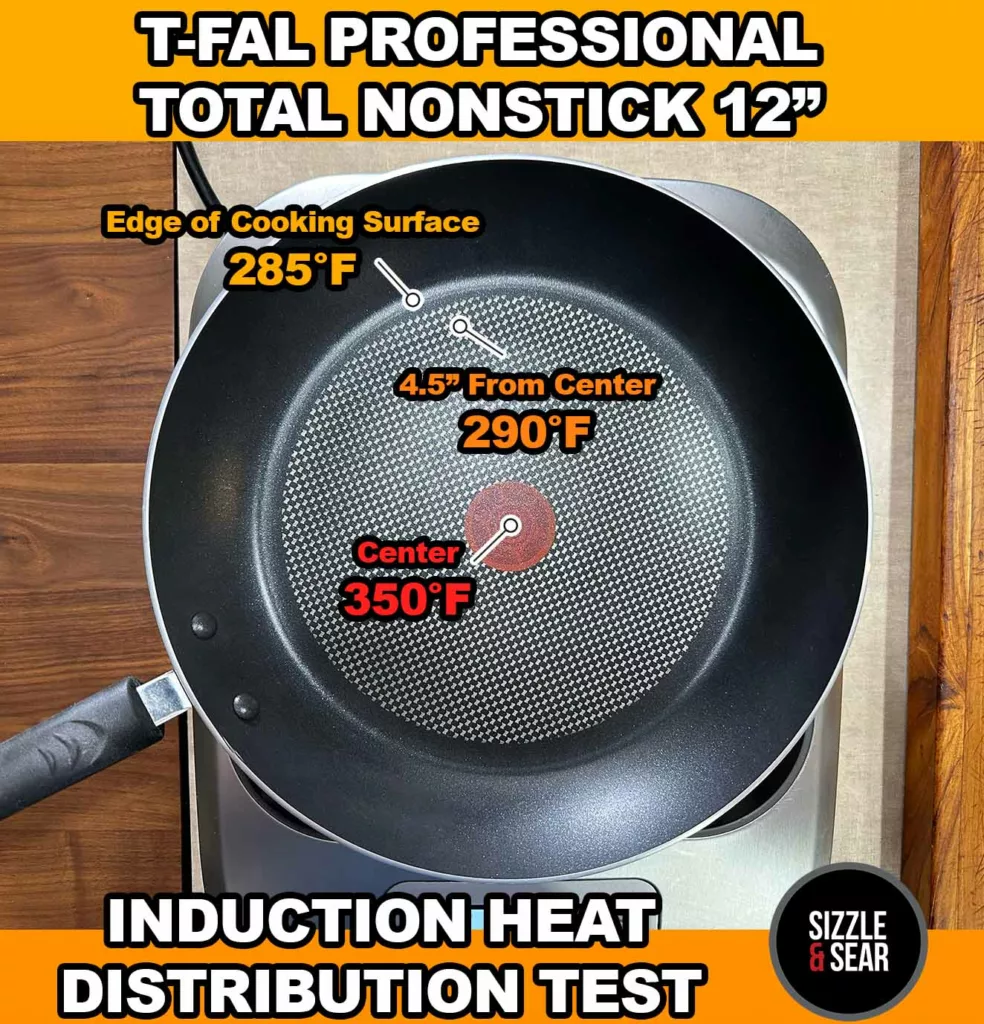
Cast Iron Cookware
Le Creuset French (Dutch) Oven
Given that cast iron is a much poorer conductor of heat than aluminum or copper, I predicted that even the best-performing cast iron cookware in my lineup wouldn’t beat the lowest-performing aluminum-clad, disc-bottomed, and nonstick pans that I tested. My prediction proved to be accurate. The top performing cast iron based pot, the Le Creuset French (Dutch) Oven, lost 68°F 4.5″ away from the center of the pan.
The Le Creuset French (Dutch) Oven features enameled cast iron, meaning it’s cast iron lined with enamel. This design reduces reactivity with acidic ingredients and simplifies the maintenance of the pan. Le Creuset French (Dutch) Ovens excel in retaining heat, making them ideal for soups and stews that require oven cooking. It’s also beautiful to look at and can brighten up a kitchen full of metal pots and pans. However, when it comes to stovetop cooking, I suggest opting for one of the higher-rated stainless steel pots and pans that will provide more even heat distribution for superior stovetop performance.
Le Creuset enamelled cast iron cookware is made in France.
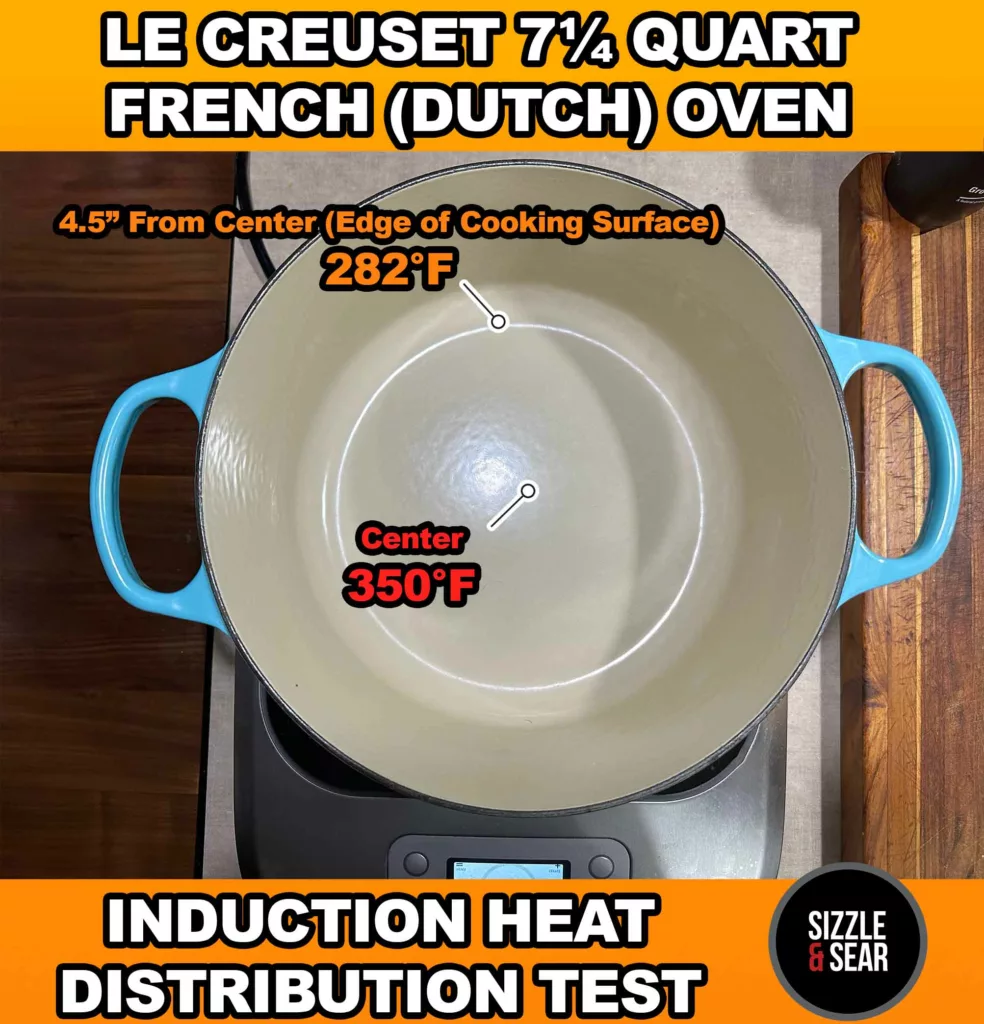
Lodge Cast Iron Skillet
While bare cast iron has an admirable rustic aesthetic and feel, it doesn’t perform any better in terms of heat distribution than enamelled cast iron.
The Lodge Cast Iron skillet that I tested lost 74° F 4.5″ away from the center of the pan.
Cast iron does have three positives though: (1) it’s affordable; (2) if it’s thick enough, it’ll retain heat pretty well; and (3) it can be seasoned to be relatively nonstick.
So if you want an affordable option of searing a steak, cast-iron can work as it’ll experience relatively little temperature drop when a cold piece of meat is added to the pan. However, due to its poor heat conductivity, I wouldn’t recommend too large of a cast-iron frying pan. Get one that’s slightly smaller than your burner for best results.
There is an an alternative to cast-iron if you are willing to spend quite a bit more. The Demeyere Proline series has 3.7mm of highly conductive aluminum at its core, which retains heat incredibly well, outperforming many cast iron pans. The aluminum contributes to a more even temperature distribution (losing just 23° F at 4.5″ from the center of the pan). And contrary to popular belief, you can get stainless steel to be nonstick for delicate foods with proper technique and a little bit of fat. I now use my smaller 8″ Proline as my omelette pan and have no sticking issues whatsoever and get perfectly non-browned omelettes every time.
Lodge cookware is manufactured in the United States of America.
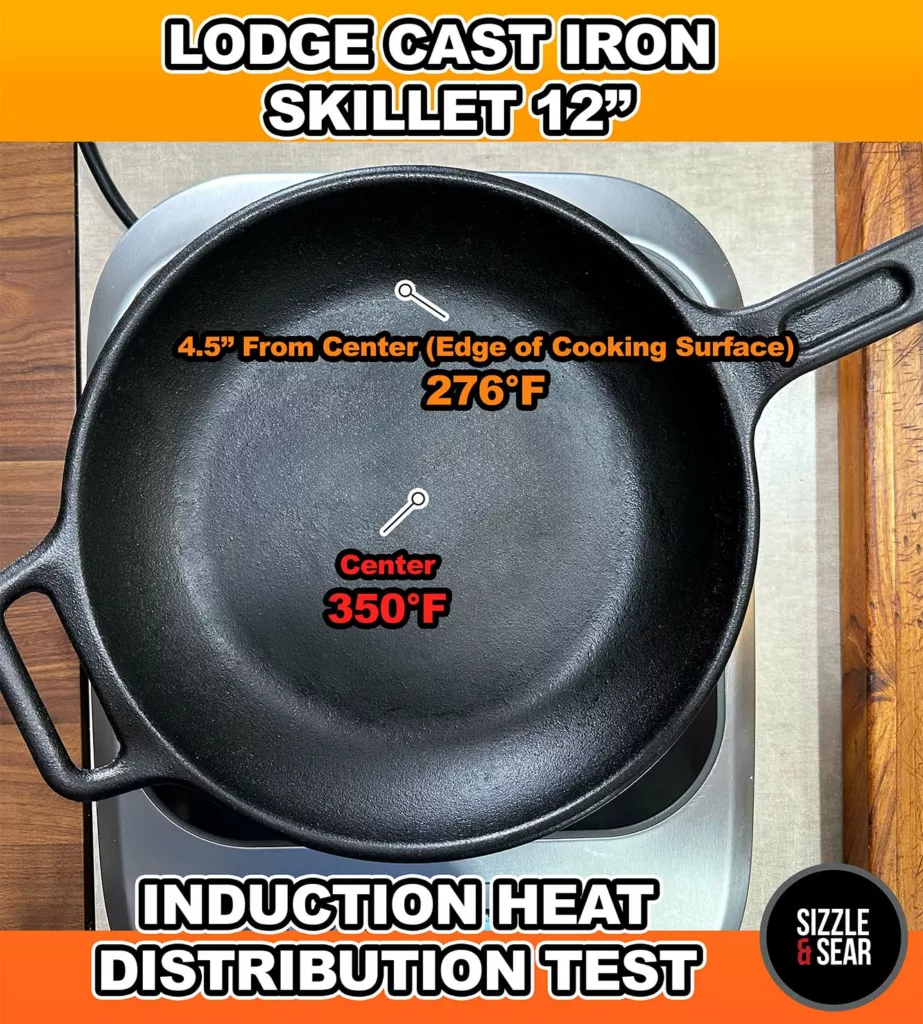
Le Creuset Enameled Cast Iron Skillet
There’s a bit of an obvious theme here: cast iron is a poor material to choose for your cookware if you care about even heating.
The Le Creuset Enameled Cast Iron Skillet is no exception. It came in last out of all our cookware, losing 88° F at 4.5″ from the center of the pan.
However, all benefits I listed for the Lodge cast iron skillet above, apply to the Le Creuset skillet with the addition of two other benefits. First, you can more easily cook reactive ingredients like tomatoes without worrying about your seasoning degrading or having a metalic taste leached into your food. Secondly, enamelled cast iron is more simple to maintain as you don’t have to build up a seasoning. That being said, the dark enamel on Le Creuset’s skillet line makes it more difficult to assess the cleanliness of the enamel than the light color enamel on their French (Dutch) ovens, if that matters to you.
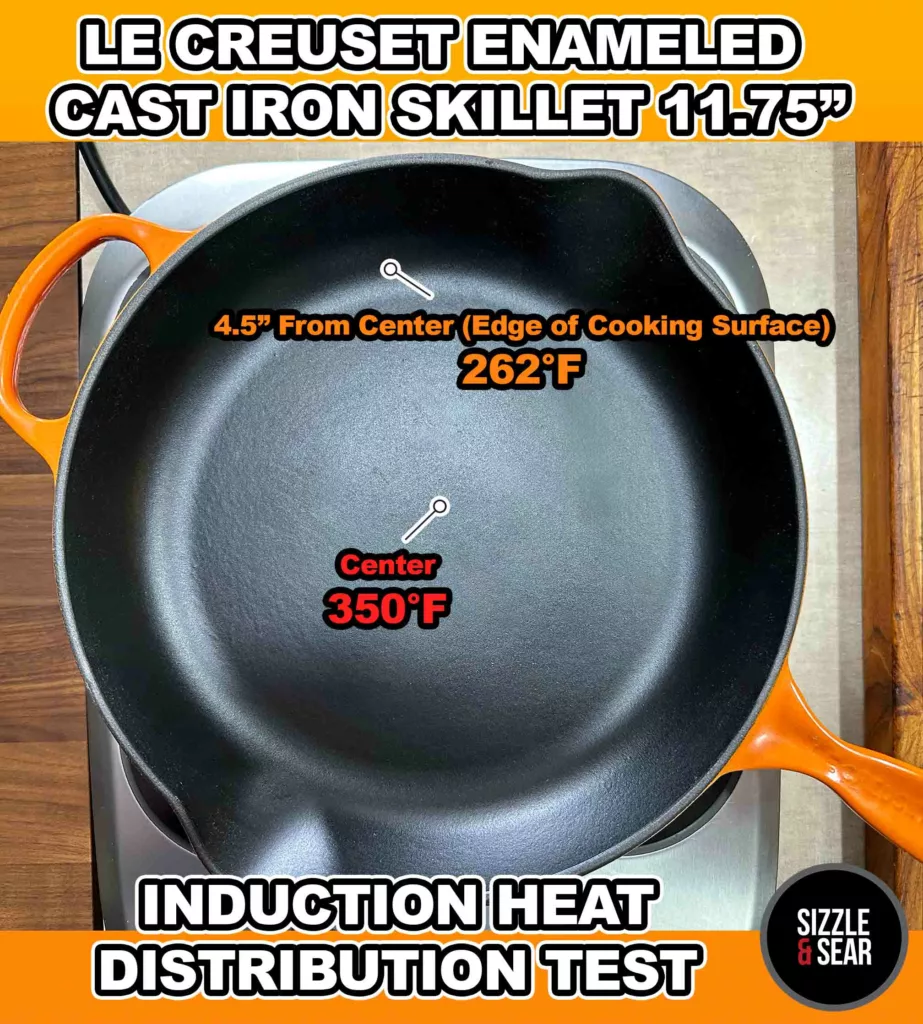
Conclusion: Choosing the Best Cookware for Your Needs
I hope you found this guide to cookware heat distribution and even heating to be useful.
What you ultimately pick depends on many factors.
If even heating is your number one goal, then you can’t go wrong with the Fissler Profi line of cookware.
However, you may like the aesthetics or larger selection of Demeyere Atlantis and Proline and choose to compromise a little on heat distribution (especially if you have proper sized burners). The copper in the Atlantis straight-sided cookware is also more reactive to temperature changes the pure aluminum core in the Fissler Profi series, and that can have certain advantages depending on what you are cooking.
If you are on a budget, you may want to look at other cookware and find something “good enough”, compromising a bit on even heating.
In the lineup of nonstick cookware I tested, there’s premium options with great heat distribution (e.g. Demeyere Alu Pro), but there’s also more budget picks in the middle of the pack (e.g. Ninja Foodi NeverStick.) It’s important to keep in mind that nonstick coatings will eventually deteriorate, so you may want to opt for a more budget friendly option and save your money for other types of cookware that will last a lifetime.
Lastly, there’s cast iron which is a poor conductor of heat, but it does have some unique benefits. Bare cast iron is relatively affordable and can retain heat well, so it’s good for searing steaks without experiencing a huge temperature drop once that cold meat hits the pan. You just want to make sure you have a cast iron pan that matches your burner size. Enamelled cast iron is more expensive, but has all the same benefits of bare cast iron, and it doesn’t react with acidic ingredients. As an added bonus, it is easier to maintain.
In the end, you have to decide what cookware is best for you, but I hope my in-depth tests and analysis has aided you in your purchasing decision.
I will continue to add to this page as I acquire more cookware, and the ratings might shift around once I get new technology to further traingulate my findings (i.e. a thermal imaging camera).
If you have any questions or comments, please don’t hesitate to leave a comment below. I’d love to hear from you!
